|

from
WeirdLord Website
Men never do evil so
completely and cheerfully as
when they do it from religious conviction.
- Blaise
Pascal (1623-1662)
THE RECENTLY deceased pontiff, Pope John
Paul II, left a decidedly mixed legacy.
While he deserves great credit for
helping prevent the fall of the Soviet Union detonate into the kind
of revolutionary bloodbath that history so often records with that
profound of a change of government, even that is not without a dark
side.
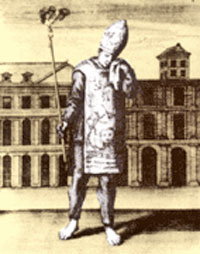 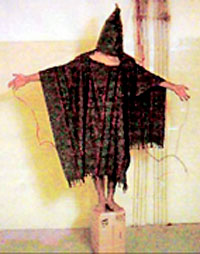
For it can be argued that the policy's
success against the atheistic regime in the West led to the
employment of religious fanatics in Afghanistan, which ironically
means that Pope John Paul's success in Poland led directly to al-Queda,
Osama, and ultimately,
September 11.
Also, John Paul II has been roundly criticized by his
supporters like the late
Malachi Martin for allowing the
Roman Church to stagnate and ossify, even as the pope himself did.
Indeed, not content with such actions
like rewarding the disgraced prelate and clergy-abuse cover-up king
of Boston, Cardinal Bernard Law, he has also been accused of
aiding in the cover-up by refusing to investigate the prominent head
of the Legionaries of Christ.
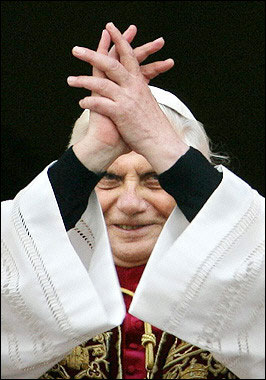
Pope Benedict XVI,
former head of the
Inquisition
In the latter years of his reign, the Holy Office of the
Inquisition, now called the Sacred Congregation for the
Propagation of the Faith, was headed by orthodoxy-czar Cardinal
Josef Ratzinger, now Pope Benedict XVI.
It once again became responsible for
dealing with the worldwide clergy abuse scandal, for John Paul
transferred all those cases involving desecrating the Eucharist or
buggering altar boys back to its jurisdiction once again. It still
ferrets out errant priests, but until the recent round of crises,
its chief interests seemed to be seeking out the theologically
treacherous ones. For those who threaten the faith have always been
considered a graver menace than those who endanger the bodies of
believers.
It will be very interesting to see whether the new pontiff will use
his power to silence dissenters or oust abusers. Yet the signs are
not good. It was recently reported that in 2001, then-Cardinal
Ratzinger signed a letter sent to all bishops, asserting the
Church's right to hold secret inquiries and keep the evidence
confidential for 10 years after the victims reached adulthood under
pain of excommunication. This continued the policy of secrecy
confirmed by "good" Pope John XXIII in the secret instructions on
Crimes of Solicitation.
Despite the hopeful spin in the press accompanying the start of his
reign, the outlook is very grim under Benedict XVI.
Rectifying
history
In any case, back in 1998, Pope John Paul II resolved to set
the record straight on that most troublesome black mark on the
Catholic Church's permanent record, the Inquisition.
Thus, he
summoned a group of 50 tame scholars, let them peek into the depths
of the Vatican Secret Archives, and issue a report of nearly 800
pages.
In 2000, perhaps fearful of Christ returning unexpectedly or due to
his own failing health, the pope went ahead and apologized for
"errors committed in the service of the truth through recourse to
non-evangelical methods." He even went so far as to "rehabilitate"
Galileo, although fudging like a diocesan lawyer might not
have been the best way to show his deep, sincere feelings.
Not surprisingly, the experts' learned verdict was that the poor
Inquisition had been sadly misjudged. The report found, for example,
that there had been trials of some 125,000 suspected heretics in
Spain, only 1% (a mere 1,250) had been executed. And in Portugal,
only 5.7% of the 13,000 tried had been condemned. It wasn't anywhere
near as bad as everyone had always said; and anyway the Church
didn't burn all those people, the State did. (AP, 6/15/04)
What a load of rubbish!
The Inquisition was simply the
most diabolical institution ever created by humanity, and the
state was for the most part merely its tool. For the pope to demur
on the depths of the Inquisition's evil is like the chancellor of
Germany refusing to condemn the Holocaust. Both are great,
unspeakably horrible spiritual scars on humanity's collective soul
whose wickedness cannot be fully comprehended.
The Inquisition might arguably be considered an even worse evil than
the Holocaust.
Though the number of victims of the
latter was higher, without the Inquisition's example of deliberate,
bureaucratic oppression, the Holocaust would not have been so easily
imaginable. Not just in its grandiose intent and direct tactics such
as the use of spies and parish registers but even in the some of the
most minor details.
For instance, yellow tunics called
sanbenitos that the Inquisition made some penitents publicly
wear inspired the yellow stars of David that Jews were forced to
don in the ghettoes, as well as the colored triangles that
distinguished the various categories of inmates in the camps.
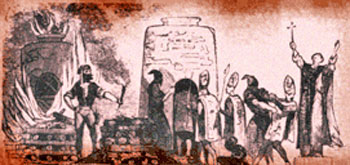
With the blessing of
a Spanish inquisitor, familiars haul the condemned,
garbed in paper
miters and sanbenitos, into a "slow oven" to be roasted alive.
This shows that not only was the
Inquisition a monstrous evil in and of itself, it has left a
legacy of horror that is unmatched.
All the repressive systems of whatever
flavor that have ever been imposed on the suffering masses of the
world have owed their inspiration to the Holy Office of the
Inquisition.
The Nazi Gestapo and secret police everywhere, including the
Soviets, Saddam and the Shah, CIA mind-control experiments,
McCarthy's Red Scare, Mao's Red Guards, the Khmer Rouge, certain
aspects of the War on Drugs and the shameful abuse and torture of
prisoners at Abu Ghraib, Gitmo, and elsewhere, all utilized
techniques pioneered by those most devoted servants of Holy
Mother Church.
The SS and the CIA have both undoubtedly
studied the old manuals with care, and for good reason.
The Inquisition perfected the use of all
kinds of torture, psychological assaults and humiliation, secret
proceedings, anonymous accusations, indefinite detentions, spies and
informers, and the confiscation of property.
The mechanisms
of repression
The Inquisition took several forms, chiefly papally-run in the
medieval period, and much more an instrument of political oppression
in its later Roman and Spanish incarnations. But in one guise or
another, it terrorized large sections of Europe for well over half a
millennium.
Threatening rich and poor alike, cleric
and lay; kings and bishops fell under its scrutiny equally as
wandering clerics and errant knights. Mighty lords, even entire
religious orders approved by the pope like the
Knights Templar, could be summoned
at any time and crushed without mercy for suspicions of which they
would not be told. Nor could they resist.
Perhaps it was inevitable in a religion that placed such emphasis on
the torture and execution suffered by its founder.
Jesus, too, had
been arrested by the religious authorities for heresy and then
killed by the civil rulers for rebellion. For hundreds of years
thereafter, Christianity had been ruthlessly oppressed by the Roman
Empire. Many missionaries had died horribly converting the invading
barbarians later as well. Finally, after a prolonged effort of
centuries, the continent had been baptized into a common faith.
Christianity began to remake Europe in
its own image.
-
Was the Inquisition, then, some
sort of revenge for the ages of persecution?
-
Was it a form of psychological
repetition of the trauma?
-
Did the omnipresent depictions
of the crucifixion used everywhere in the Latin Church, the
constant emphasis on the betrayal and murder of Christ
lead to some sort of psychological need to re-enact it
repeatedly?
-
Did the fear of hell make them
create a real one on Earth?
Like the thirst for red martyrdom in the
early Church, or the recent biblical gore-fest, The Passion of
the Christ, there is an unhealthy and morbid sadism
somehow involved.
In any case, the Inquisition was an iron reign of terror like none
ever before. It marked the triumph of papal politics but also the
fatal weakness that was hidden at its very heart: the fact that the
pope's power depended solely on the consent of the faithful.
The medieval Inquisition came into being by 1233, at the behest of
Pope Gregory IX, the violent culmination of a long process of
confronting heresy. Under his predecessor, the imperial Pope
Innocent III, the papacy had recently attained a temporary supremacy
of sorts over the German emperors and other secular powers who had
often, in the pope's view, flirted with heresy by doing totally
unacceptable things like choosing their own bishops.
Innocent did his best to make sure that
Rome would stay on top by creating the canonical and organizational
groundwork for an international strike force of trusted agents that
could go anywhere to drag anyone off to their secret detention
centers where they could use any means necessary to extract the
truth. (Sound familiar?)
Such extreme measures were needed, it was universally believed,
because of the rise of heresy. As the Church became richer in the
Middle Ages, corruption grew, and the old standards of piety and
ascetic purity declined. Many reformers sought to reverse this by
appealing past the intermediacy of the Church directly to the Gospel
and its emphasis on the poor.
Some even organized their followers into
orders.
A fortunate few, like Francis of Assisi,
obtained a sympathetic hearing and approval. While some of his
followers went on to become heretics when they denied the Church's
right to property, others were co-opted by that same Church to serve
as persecutors. Some would-be reformers, like Peter Waldo of Lyons,
were less lucky or perhaps more opinionated, having read the Bible
for themselves, and were duly condemned.
Old heresies like Manicheanism also resurfaced in new forms
like
Catharism and the
Albigensians. These were even more world-denying than medieval
Catholicism, which is no mean feat. The extreme asceticism of their
clergy, the perfecti, contrasted poorly with the established
and worldly Catholics, whom they saw as servants of a false creator
god.
The Christian hierarchy saw this as an assault from without, blaming
wandering minstrels and returning Crusaders, who may indeed have a
hand in spreading it along with the Bogomils, Manichean missionaries
from Bulgaria. It is from their alleged sexual practices that the
word bugger is said to come.
The cardinals suspected, however, that there was an organization
from outside Christendom behind it all. Indeed there may have been.
Modern scholarship has found evidence that the claim that there was
a "Cathar pope" directing operations before the Muslim invasion from
what is now Bosnia may have been accurate.
Thus, the Church realized it was in a
struggle for the very soul of Europe, and was willing to do whatever
it took to retain its control.
The worst
crime
To be called a heretic in the Middle Ages was a deadly serious
business. Due to the intertwining of Church and State, to be at odds
with one was to deny the other also. Heresy, a crime of the soul,
was treason, and treason, heresy.
As St. Thomas Aquinas confidently
wrote,
"If forgers and malefactors are put
to death by the secular power, there is much more reason for
excommunicating and even putting to death one convicted of
heresy."
Princes were thus often anxious to
co-operate and prove their orthodoxy, if only to keep suspicion from
themselves. For the Church said a heretic could not hold any office
legitimately; indeed, his lands and property were legally forfeit to
whatever good Christian could seize them.
The Inquisition got its bloody start during the long and vicious
Albigensian Crusade, where southern France was devastated by a
coalition of greedy lords from the north.
There was a basic problem distinguishing
devout Catholics from heretic
Cathars, which inspired one crusader to say,
"Slay them all, God will know his
own," and act accordingly.
Heresy was a thought-crime, a subversive
attitude against God's church, but hard to detect as it often
masqueraded as holiness.
Heretics craftily spoke in code and so
had to be tricked into exposing themselves, hence the use of torture
in interrogation, secret accusations, spies, and long-term
surveillance.
Techniques of
the theological thought police
The Inquisition became quite sophisticated in its approach. In the
medieval form, when an area was deemed to be infested with heretics
- say, when there had been resistance displayed to the excessive
donations, then a team of inquisitors would be sent in.
Armed with
authorizing documents from pope and prince, they would always travel
in pairs.
This not only allowed them to keep an
eye on each other, but permit them as priests to absolve each other
of any blood-spilling or other unpleasantness required in their
work. Inquisitors could not only go after anyone, they could absolve
anyone of any sin, sell the goods they confiscated, and got full
indulgences for their pains, so they could not only enrich
themselves in this life, but be assured of a well-earned paradise in
the next.
Accompanied by the local lord's guards, a chief minion called a
"familiar" and his stooges, and a secretary provided by the local
bishop to officially record the proceedings, the inquisitors would
parade into a town after it had been prepared by the vigorous
preaching of the local clergy, who would of course, all be in
attendance. There, at the chief church or cathedral, the inquisition
would be proclaimed in a grand public spectacle. A "general sermon"
would be read detailing the procedures and penalties, and all
sinners were invited to come forward and confess their sins on the
spot in order to be granted clemency.
Many, especially those who had seen an inquisition in action before,
would promptly do so. For it was not just a crime to be a heretic,
it was also a crime to be in any way favorable or merely impressed
by their seeming holiness.
"Fautors" or "listeners" were targeted
as were the most hardcore members of a movement. To be called a
fautor was an accusation quite enough to ruin one's life. And of
course, any hesitation, resistance, or questioning could be seen as
evidence of a dangerously bad attitude.
The penitents were of course required to inform on others in the
community, as were the clergy, who were under even more suspicion.
Innocent had proclaimed that the corruption of the people had
stemmed from that of the clergy, after all. A panel of judges would
be set up that might include local experts or representatives of the
religious establishment along with the inquisitors, and they would
quickly begin to debrief the clergy and penitents in secret.
Those unfortunates so named by their neighbors would soon be
ambushed or hauled off in the middle of the night by the chief
familiar and his crew. The very fact that the accused had not
already confessed was in itself suspicious. They would not be told
of what they were suspected, however; instead, they would be asked
if they knew why they had been arrested.
Even then, Catholic guilt was expected
to work wonders.
In that unhappy situation, the accused had a few small chances of
escaping unharmed. Claiming innocence was not usually one of them,
unless they could quickly and accurately name their unknown accuser
as an enemy. Such accusations were thrown out, one of the rare
safeguards in the system. Otherwise, if the accused confessed to the
right thing, it was a minor first offense and they cooperated fully
(usually by squealing on others), they might obtain leniency.
Usually, however, they were screwed,
plain and simple, and often literally.
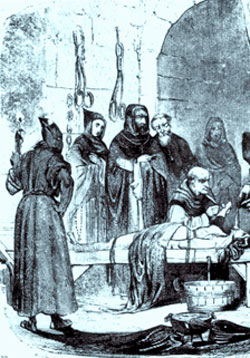
Inquisitors busily at
their trade.
Notice the secretary
ready to record any confession that might gurgle past the drowning
victim's lips.
Under "vehement suspicion" of heresy, victims could be held
indefinitely at the whim of the inquisitor.
Sometimes this stretched into decades.
At any time, prisoners could be let out and brought back again for
the same offense. There were no limits on the number of times they
could be accused. Better food and conditions, even books on
occasion, could be procured from the familiars, who used this
privilege to line their pockets.
Property was frequently confiscated
outright, providing fuel for further persecutions since the
inquisitors were welcome to sell it off to finance their programs,
just as in the War on Drugs today. Most legal protections for
citizens that American citizens enjoyed until recently were
ultimately a reaction to the methods used by the inquisitors. The
Founding Fathers, suspicious of British tyranny, were even more
jaundiced against popery and its pretensions.
Suspects of the Inquisition could be denied the sacraments, even a
Christian burial. Years after their death, their bones could be dug
up and burnt, for there was no statute of limitations on heresy.
Even would-be saints were not immune. Armanno Porigilupo, for
instance, an Italian Cathar who was caught, recanted, and led a
saintly life thereafter, was hailed as a Catholic saint immediately
after his death, a grand altar erected over his tomb and was soon
said to have caused many miracles.
This quite outraged the local inquisitors.
Through five inquests,
nearly half a century, they argued until a papal commission decided
in 1301 the blessed Armanno had indeed been a secret Cathar all
along. His body was dug up and relics burned, the altar thrown down,
and the inquisitor became the new bishop. As in this case, all too
often the Inquisition was seen as political, a perception that grew
strong in Rome and Spain. The bloodiest inquisitors such as St.
Peter of Verona and Conrad of Marburg were not above wielding any
political influence to achieve their gory and paranoid ends.
Worst of all that could befall one was to relapse into error after
being once forgiven. For those, there could be no mercy for they
were deemed irredeemably corrupt. It was usually the stake for them
no matter what they pleaded.
If it came to torture, the options were as fertile as the fevered
inquisitors' imaginations. The first stage of torture was the mere
displaying of the instruments newly-forged just for the occasion to
the prisoner; the second was heating them up in front of the poor
wretch. Only then, in the "third degree," would they be actually
applied to flesh. The questioning would be methodical but devious,
and woe to any unfortunate soul about whose answers the secretary
noted, "the inquisitor was not satisfied."
Torture would proceed in gradual stages, until the inquisitor either
was contented or the accused had perished, though care was supposed
to be taken to prevent the latter.
As for theological questions, the safest
answer was,
"I believe whatsoever the holy
inquisitor instructs me to believe."
But even that was no guarantee.
If the questioner detected any evasion
or duplicity, he was required to be merciless for the sake of his
victim's soul.
Punishment as
propaganda
As the papal commission rightly points out, only a small proportion
were actually burnt. Many lesser punishments involved imprisonment
or fasting for years, publicly wearing garments, or placards, or
symbols, such as huge wooden dice for gamblers.
Monasteries, which already served the medieval world as hospitals,
hotels, libraries and research centers, took on the additional role
of religious prison. "Houses of the strict observance" were
particularly well-suited to locking up clerical criminals, but the
presence of men with no vocation or desire to be there was
inevitably corrupting. It actively contributed to the loss of esteem
that monks suffered leading up to the Reformation.
Those who were executed or publicly punished in some way were done
so in a closing spectacle even grander than the general sermon at
the beginning. The Church did not take the blame for the death
penalty; instead, it "relaxed" the victims into the tender mercies
of the State, which would then conduct the actual immolation.
But to claim the Church was therefore
not responsible for the burnings is about as believable as that it
was the low-ranking guards behind the photographed horrors in Iraq.
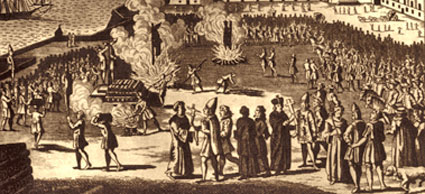
A Protestant view of
a late 17th century auto da fe in Lisbon.
One must have gotten away: on the far pyre, a mannikin is burning in
effigy.
The papal and Spanish "auto da fe" were important festive social
occasions to demonstrate the full might of Catholic power as well as
granting the condemned heretic a chance to show his or her mettle.
Huge processions with much pomp and ceremony would be undertaken to
the place of execution. If the heretic had escaped or was otherwise
unavailable, a dummy would be burnt in his place.
The lucky ones were strangled before burning; those who were being
used as a lesson, were not.
Giordano Bruno, for instance,
was burned alive in an iron mask that pierced his tongue so he
couldn't scream, and his agonized breath made it whistle.
Afterwards, the remains of such infamous heretics would be scattered
in the nearest river to prevent them from becoming relics.
In time, the Inquisition inspired some to try using its techniques
for social improvement. These gave mixed results in terms of
punishing adultery, gambling, and drunkenness. However, the
Inquisition was wildly successful in finding new sources of helpless
victims when it finally turned its attention to witchcraft.
At first, the inquisitors were forbidden to go after sorcerers
unless there was heresy involved. Only in the late fourteenth
century when the theologians decided that any resort to magic
involved worshipping the Devil and thus heresy that supposed
practitioners of the occult became fair game. Before this, for
instance, the learned doctors had believed that the witches'
sabbats were entirely illusory.
Once such dreadful things were
accepted as real, the dangers they presented to Christians then had
to be opposed - a classic case of creating one's own enemy.
Yet, even there the Inquisition was not entirely successful. In
Spain, for example, so many people came forward to confess to being
witches that the authorities could not handle the crowds. They
therefore reasoned that the people were deluded and there were no
brujas in Catholic Spain, and thus the Spanish Inquisition
busied themselves with crypto-Jews, Muslims, and Lutherans. (The
False Memory Syndrome people would have been pleased.)
Though it helped eliminate the Albigensians and Cathars, the
Inquisition ultimately failed in many respects. Proto-protestant
Waldensians, followers of Peter Waldo, fled to the mountains
and survived, as did the Hussites of Bohemia hundreds of years
later.
Finally, Martin Luther was able
to narrowly avoid the clutches of the Inquisition through princely
protection and public support mobilized by the new instrument of
free communication that the Church could not control, the printing
press. Ironically, that same invention had not long before spread
the infamous inquisitorial handbook,
The Hammer of the Witches, across
Europe.
In the mad times to follow, the
Protestants would do their own share of witch burning inspired by
its theories.
An inheritance
of iniquity
The Inquisition left in its wake a vast legacy of profound evil. It
refashioned the Catholic Church into an intellectual dictatorship, a
religious police-state where the appearance of conformity remains
all-important. To this day, secrecy still rules. And society has
paid the price.
Galileo, for example, learned
well the lessons left by Bruno, wisely denied the evidence of
his senses, and science has since languished in Italy.
As a result,
most of the great innovations of modern times and the material
wealth they have produced have mainly come from Protestant
dominions. With such enforced intellectual rigidity comes a stifling
of creativity in fields other than science as well. Everything from
theology to art is diminished and falsified.
The Inquisition did, of course, maintain the strictest control over
publishing in the Catholic sphere. It judged which books could be
published and which should be condemned. Hence the infamous Index
of Forbidden Books and the imprimatur system, whereby a bishop
would have to approve books for Catholics before they could be
printed. Needless to say, the tyrants of the world have found this
inspirational, too.
The operation of legal system by the Church, complete with dire
punishments, outside and overriding secular jurisdiction, buttressed
the expectation that the Catholic Church took care of its own, good
or bad. At one time, all it took was for an accused man to read the
Latin from the parish Bible to prove he was an educated cleric and
he would be turned over to the Church for judgment and discipline,
which was usually less harsh. This is what the term "benefit of
clergy" actually meant.
This attitude has been a major factor in the long cover-up of clergy
sexual abuse. The Church was expected to judge its failed ministers
and keep them away from the vulnerable laity. And thus there were
"treatment centers" essentially monasteries with programs of prayer
and meditation, like those of the Servants of the Paraclete
who basically enabled clerical perpetrators to be recycled from one
side of the continent to the other. This is a direct legacy of the
Inquisition and the medieval church.
The terror that was the Inquisition forced everything unacceptable
into the fetid underground it had created, both the sexual
acting-out of priests as well as unacceptable theology, where such
things were free to mingle and mutate. Its violence radicalized its
victims, too, some of who incorporated torture and bloodletting in
their own secret cults to order to learn to endure capture.
Paradoxically, the Inquisition is
therefore probably more responsible for the secret rings of criminal
clerical perpetrators and Satanists, in and out of the Church, than
anything else.
It could be expected the greatest harm done by the Inquisition is
that it has permanently stained the Roman Catholic Church,
discrediting it in the eyes of the world, forever causing its
motives to be doubted by outsiders who remember. But that oddly
enough, is not the case. The papacy, whose tool it was, should be
held in utter contempt and horror. After all, was not the
Inquisition the polar opposite of everything good that the Church
claims to be?
Perhaps the awareness of what people can do to their fellow humans
in the name of God is just too awful to contemplate for long.
Given the reactions to the sickening pictures from Iraq, that may
indeed be so.
In any event, the Inquisition itself endures. And now the former
head of its modern incarnation has become the Supreme Pontiff. Time
will tell if Pope Benedict XVI uses it to clear out the rot,
or drive the few remaining Catholics not already bound in
dogmatic chains from the temple.
We may not have to wait long.
|






